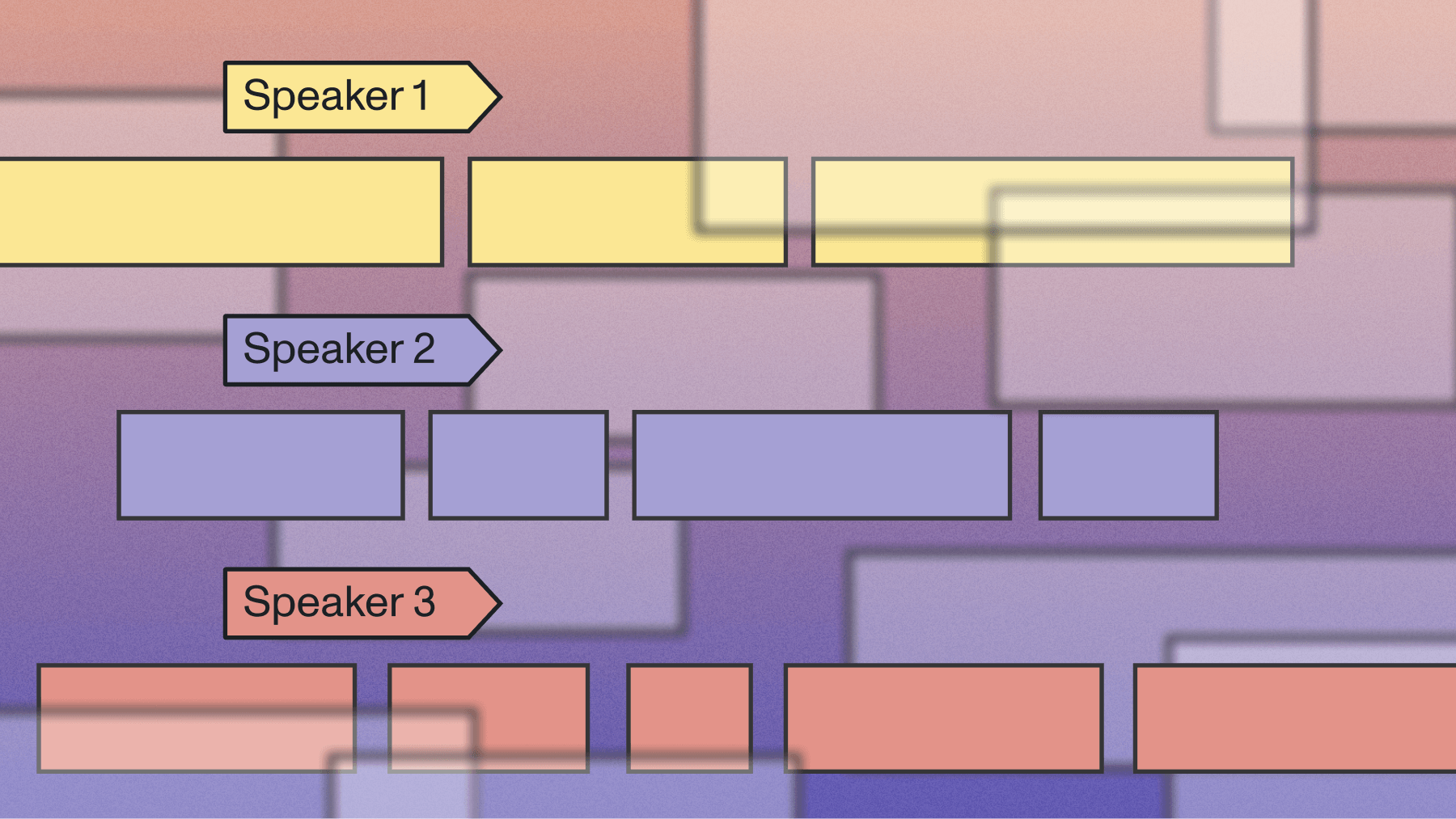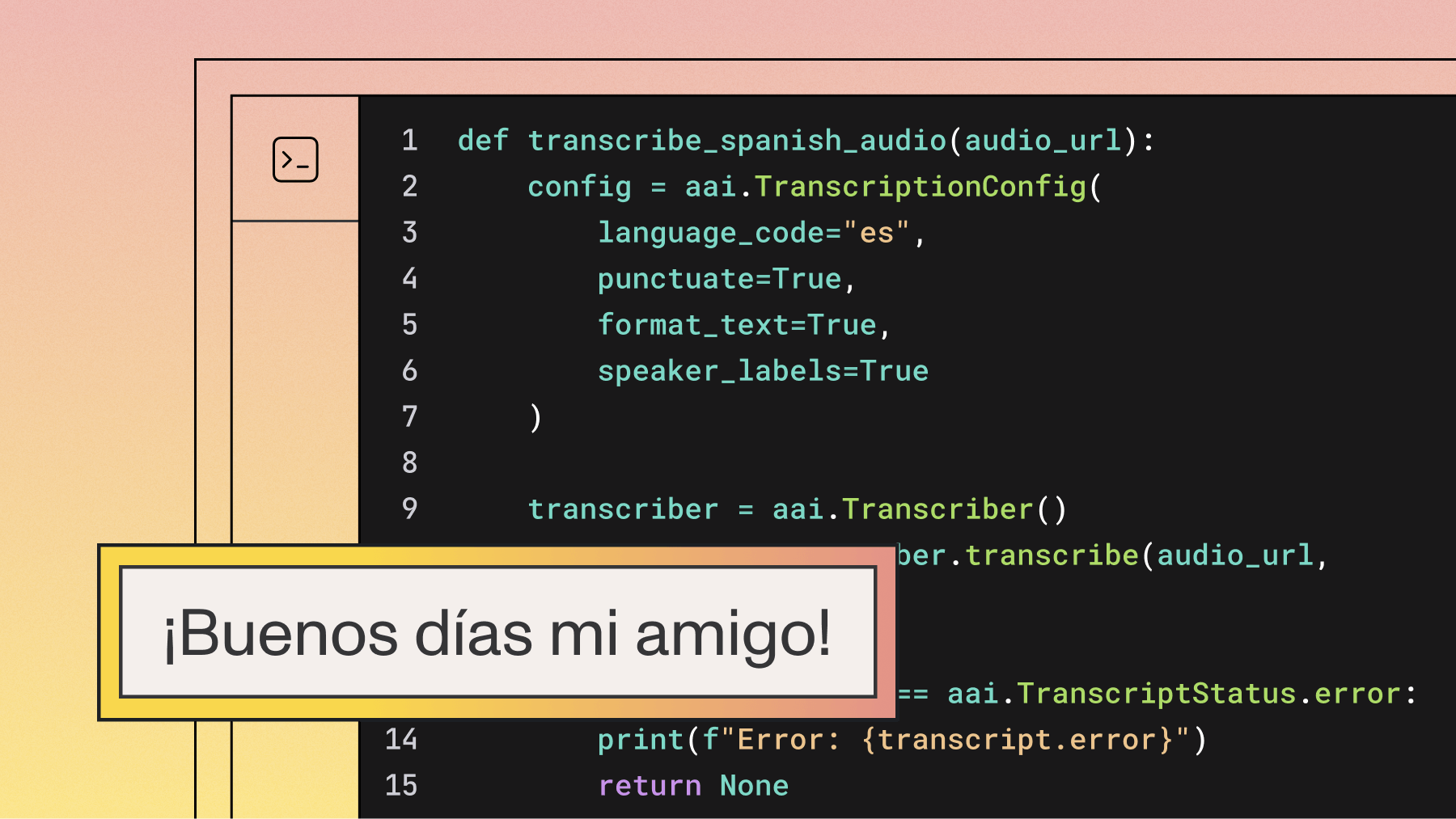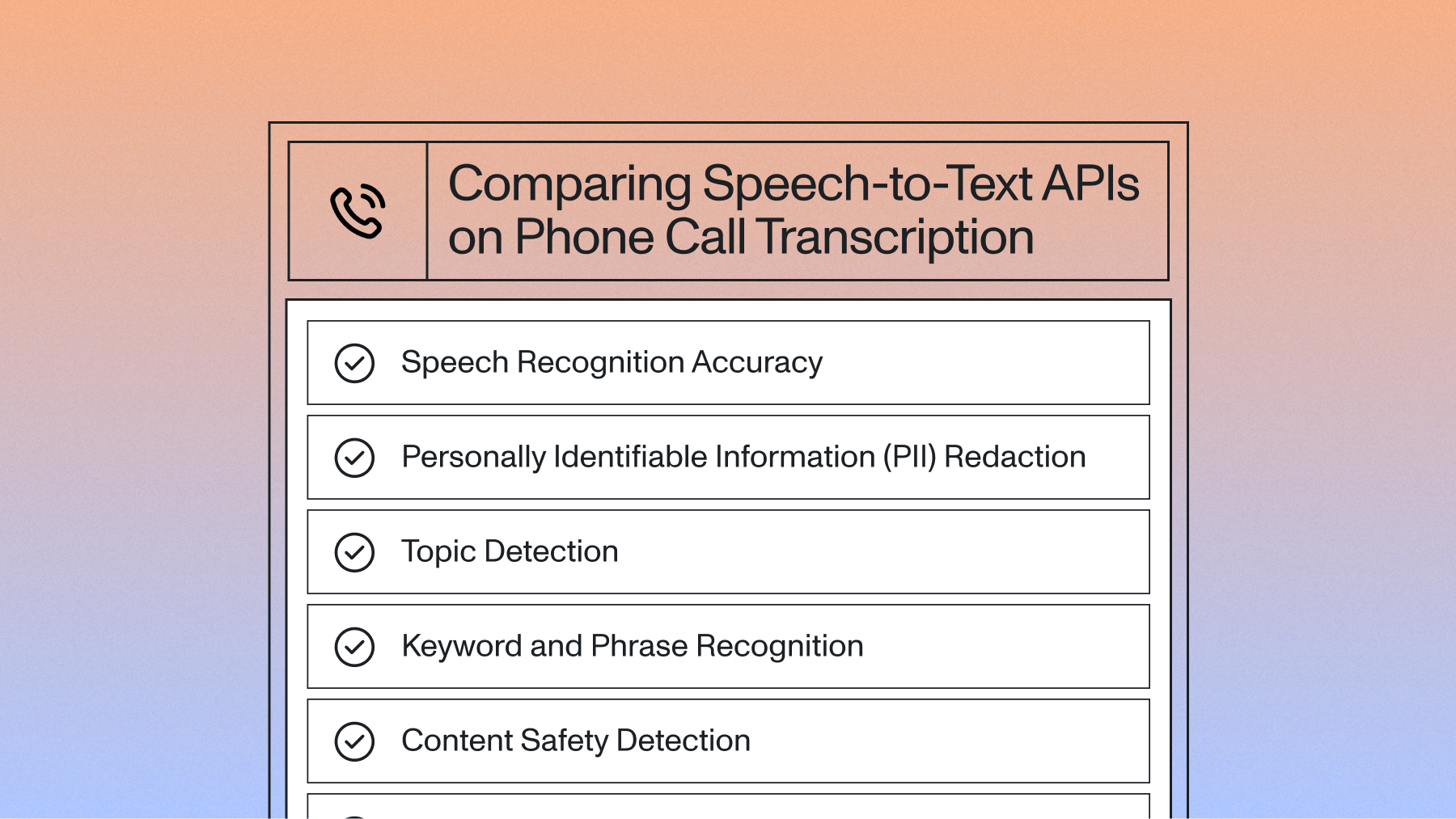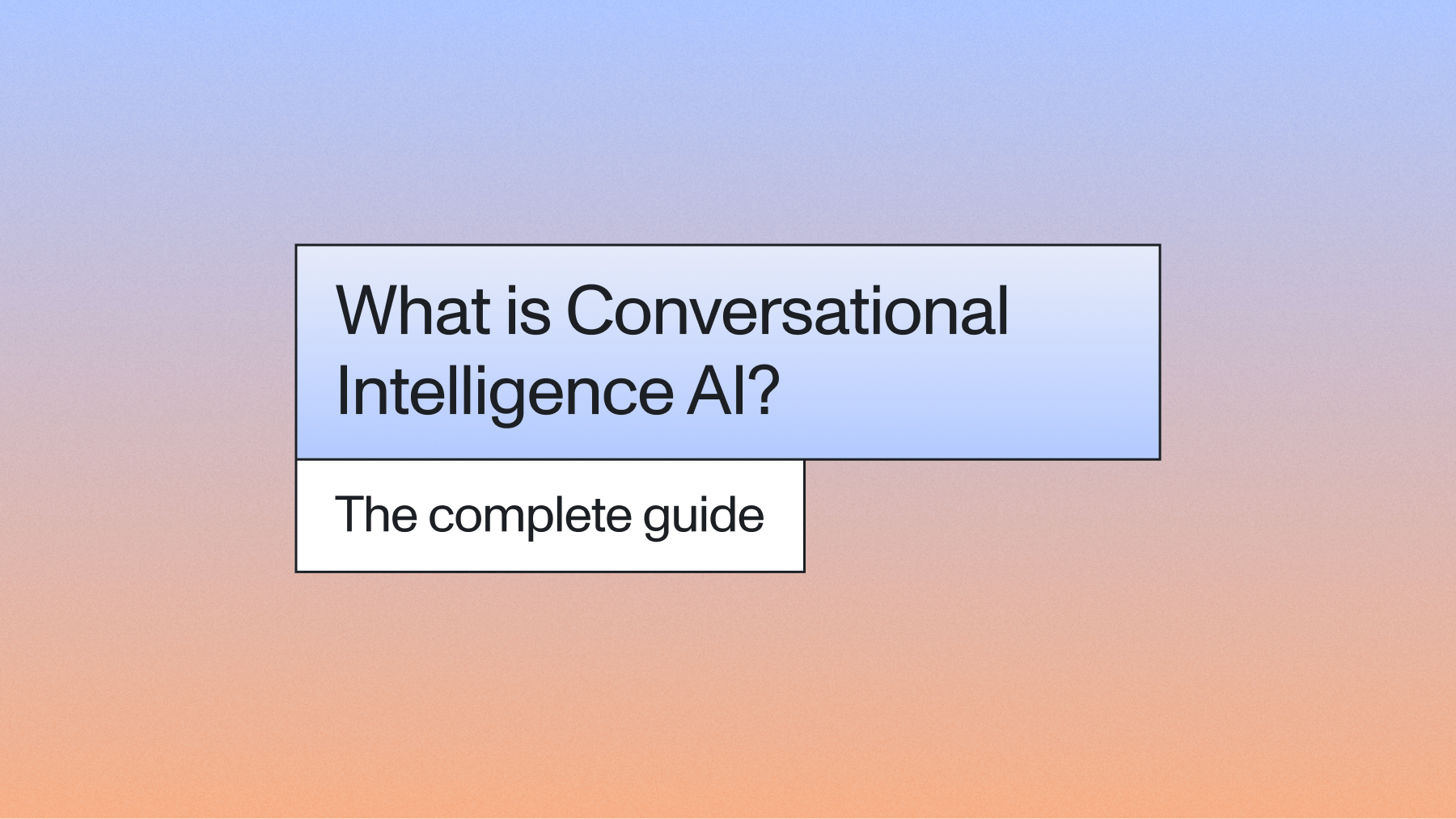5 Deepgram alternatives in 2025
Compare five Deepgram alternatives—AssemblyAI, Google Cloud Speech-to-Text, AWS Transcribe, OpenAI Whisper, and Speechmatics—based on accuracy, pricing, and features to find the right speech-to-text API for your requirements.



Compare five Deepgram alternatives—AssemblyAI, Google Cloud Speech-to-Text, AWS Transcribe, OpenAI Whisper, and Speechmatics—based on accuracy, pricing, and features to find the right speech-to-text API for your requirements.
Deepgram alternatives at a glance
The best Deepgram alternatives are AssemblyAI, Google Cloud Speech-to-Text, AWS Transcribe, OpenAI Whisper, and Speechmatics. Each provider offers automatic speech recognition (ASR) that converts your audio files into text, but they differ in accuracy, pricing, and extra features.
What is Deepgram?
Deepgram is a speech-to-text API that turns spoken audio into written text using their Nova-2 AI model. This means you can upload audio files or stream live audio, and Deepgram will give you back a transcript with features like speaker identification and punctuation.
Deepgram provides streaming APIs for real-time transcription (like live captions) and batch APIs for processing recorded files.
You'll find Deepgram supports over 30 languages and provides code libraries for Python, JavaScript, .NET, and other programming languages. Its pricing starts around half a cent per minute for basic usage.
Why look for Deepgram alternatives?
Consider a Deepgram alternative when your specific requirements don't align with their capabilities. Here's what drives teams to switch:
Accuracy needs: Your application might need better performance with specific accents, technical jargon, or noisy audio environments. Different providers excel at different types of audio—what works great for clear podcast audio might struggle with phone calls or medical terminology.
Pricing structure: Deepgram's per-minute pricing doesn't fit every use case. High-volume applications often need volume discounts, while some teams prefer different billing models that match their usage patterns better.
Missing features: You might need capabilities beyond basic transcription. Advanced PII redaction that automatically removes social security numbers, built-in sentiment analysis, or custom vocabulary support can be dealbreakers if they're not included.
Compliance requirements: Enterprise deployments often require specific certifications like SOC 2 Type 2, HIPAA compliance with Business Associate Agreements, or GDPR data retention policies. These aren't optional for regulated industries—they're mandatory.
Integration challenges: Better documentation, clearer code examples, or more robust SDKs can save weeks of development time. Some teams also need on-premise deployment options that cloud-only providers can't offer.
Rate limits can also become bottlenecks. Deepgram's concurrent connection limits might not handle your peak traffic, especially for applications with sudden usage spikes.
Top 5 Deepgram alternatives
1. AssemblyAI
AssemblyAI delivers industry-leading accuracy while including advanced features like sentiment analysis and PII detection that other providers charge extra for. This means you get transcription plus Speech Understanding like sentiment analysis and PII detection in one API call.
The platform processes audio through advanced AI models that don't just transcribe—they understand the content.
Beyond basic transcription, AssemblyAI includes features that typically require multiple services:
- Sentiment analysis: Detects emotions and tone at the sentence level
- Auto chapters: The Auto Chapters model summarizes audio data over time into chapters. Each chapter contains a summary, a one-line gist, a headline, and start/end timestamps
- Entity detection: Identifies people, places, organizations, and other important entities
- Content moderation: Flags sensitive or inappropriate content
- LLM gateway framework: Applies Large Language Models to generate summaries, answer questions, or extract action items
Developers on G2 consistently highlight AssemblyAI's documentation quality and responsive support. The platform holds a 4.8 out of 5 star rating, with users rating ease of use at 9.3 and quality of support at 9.6—well above industry averages. One developer noted: "Assembly has been the go-to for our business for all things Speech to Text related. We love the ease-of-use with integration, extremely clear documentation, and phenomenal support."
According to G2 reviews, AssemblyAI scores 9.3 for ease of use and 9.6 for quality of support—well above industry averages. Developers highlight the comprehensive documentation and working code examples that make integration straightforward.
AssemblyAI maintains SOC 2 Type 2 certification and offers HIPAA-compliant processing with Business Associate Agreements. This makes it suitable for healthcare, finance, and other regulated industries where data security isn't negotiable.
2. Google Cloud Speech-to-Text
Google Cloud Speech-to-Text integrates with Google's cloud ecosystem. If you already use Google Cloud Platform, this native integration can streamline your workflow. The service offers standard and enhanced models—enhanced costs more but delivers better accuracy for challenging audio like phone calls.
Speech adaptation is where Google shines. You can boost recognition of specific phrases through hint phrases and custom vocabularies without retraining models. This means adding up to 5,000 domain-specific terms and assigning boost values to improve recognition of your industry jargon.
The API supports over 125 languages and variants—the most extensive coverage among major providers. You'll get automatic punctuation, profanity filtering, and word-level timestamps with confidence scores.
Key integration benefits include:
- Direct connection to Google Cloud Storage for batch processing
- Built-in speaker diarization for multi-speaker audio
- Streaming recognition with interim results for real-time applications
- Long-running recognize for files up to 8 hours
Google's pricing starts at $0.006 per minute for standard models. Enhanced models cost $0.009 per minute but often justify the premium through improved accuracy on phone audio and noisy environments.
3. AWS Transcribe
AWS Transcribe fits naturally into Amazon Web Services workflows, making it the default choice for teams already using AWS infrastructure. The service excels at call center use cases through specialized features you won't find elsewhere.
Channel identification separates stereo audio channels automatically. This means you can analyze agent and customer conversations independently without manual preprocessing. Custom language models let you train domain-specific vocabularies by uploading text data, improving recognition of industry terms or product names.
AWS Call Analytics provides specialized features for contact centers:
- Automatic call categorization based on conversation content
- Sentiment analysis throughout the entire conversation
- Talk time analytics and interruption detection
- Issue detection and resolution tracking
AWS Medical Transcribe offers a separate service optimized for healthcare. It recognizes medical terminology, medication names, and anatomy terms that general speech recognition models struggle with.
Vocabulary filtering helps maintain brand standards by automatically removing or masking unwanted words. The streaming API supports real-time transcription, though latency can vary based on your AWS region and configuration.
4. OpenAI Whisper
OpenAI Whisper offers unique flexibility through two deployment options: a completely open-source model you can run yourself, or a managed API service. This flexibility makes it different from other major speech-to-text providers.
The open-source version includes five model sizes—tiny, base, small, medium, and large. Smaller models run faster but sacrifice accuracy, while the large model achieves excellent results but needs significant GPU resources. A typical large model requires at least 10GB of VRAM for efficient processing.
Self-hosting provides:
- Complete control over data privacy and retention
- No per-minute costs after initial infrastructure setup
- Ability to fine-tune models on your proprietary data
- Beam search decoding for improved accuracy
- Voice activity detection for automatic audio segmentation
The Whisper API removes infrastructure complexity entirely. At $0.006 per minute, it handles transcription without managing servers or GPUs. The API version processes faster than most self-hosted deployments and includes automatic language detection.
Whisper does well at multilingual transcription, supporting 99 languages with impressive accuracy across most of them.
5. Speechmatics
Speechmatics focuses on deployment flexibility, offering cloud, on-premise, and edge solutions. This makes them popular with enterprises that need to process sensitive audio without sending it to external cloud services.
Its real-time ASR achieves low latency through optimized streaming protocols. The batch transcription API handles large volumes efficiently, with automatic language identification across 50+ supported languages.
Deployment options include:
- Cloud API with global endpoints for standard use cases
- On-premise containers for data sovereignty requirements
- Edge devices for offline processing in remote locations
- Downloadable language packs for air-gapped environments
The platform includes speaker diarization, punctuation, and casing as standard features. Published accuracy benchmarks show strong performance across different accents and acoustic conditions.
Speechmatics provides detailed confidence scores at the word level, helping your applications make informed decisions about transcription quality. Their enterprise support includes custom model training for specialized vocabularies or unique acoustic environments.
What to consider when choosing a Deepgram alternative
Selecting the right speech-to-text API requires evaluating multiple factors beyond basic transcription capabilities. Here's what matters most:
Accuracy vs speed trade-offs matter for your specific use case. Real-time applications like voice assistants might accept slightly lower accuracy for faster response times. Batch processing applications like podcast transcription can use more sophisticated models since latency isn't critical.
Total cost of ownership includes more than API pricing. Factor in development time, maintenance overhead, and the cost of building features that some providers include as standard. A cheaper API that requires extensive post-processing might cost more overall.
Scalability considerations become crucial as you grow. Check rate limits, concurrent connection caps, and SLA guarantees. A provider that works great for prototypes might hit limits in production. Volume discounts can reduce costs significantly—some providers offer substantial discounts at scale.
Why developers choose AssemblyAI over Deepgram
AssemblyAI ranks highly in third-party accuracy benchmarks while including features like sentiment analysis and PII detection that other providers charge extra for. In G2 comparisons, AssemblyAI scores higher than Deepgram in quality of support, and users report that AssemblyAI's "meets requirements" score of 9.1 indicates strong feature alignment with customer needs.
Speech Understanding features eliminate the need for multiple API calls. Instead of transcribing with one API, then sending text to another service for sentiment analysis, then another for PII detection, AssemblyAI handles everything in a single API call. This reduces latency, complexity, and costs.
PII redaction automatically identifies and removes over 30 entity types including social security numbers, credit cards, medical record numbers, and personal health information. The feature works across all supported languages without any configuration on your part.
The LLM gateway framework applies Large Language Models directly to your transcripts. Generate summaries, extract action items, answer questions, or create custom insights—all without managing separate LLM infrastructure.
Custom vocabulary improves recognition of proper nouns, technical terms, and brand names.
Enterprise customers benefit from 99.99% uptime SLAs, dedicated support channels, and volume pricing that scales with growth. The platform processes billions of minutes monthly, proving its reliability at enterprise scale.
The developer experience includes comprehensive documentation with working code examples in multiple programming languages. Every API endpoint includes detailed guides that make integration straightforward, even for complex features like streaming transcription or real-time speaker identification.
Frequently asked questions
Does Deepgram work better than Whisper for real-time transcription?
Deepgram typically offers lower latency for streaming transcription with real-time factors around 0.2–0.3x, while self-hosted Whisper's speed depends entirely on your GPU hardware. The Whisper API provides consistent performance but isn't optimized for real-time streaming like Deepgram's streaming endpoints.
Which speech-to-text API has the highest accuracy for phone calls?
AssemblyAI performs well in accuracy benchmarks across different audio types including phone calls, while Google's enhanced models and AWS Transcribe also perform well on telephony audio. The "best" depends on your specific audio quality, accents, and domain terminology.
Can you use AssemblyAI without paying monthly fees?
AssemblyAI offers free credits for testing and development when you sign up, giving you access to all features including streaming transcription and audio intelligence capabilities. There are no monthly fees—you only pay for the audio minutes you process.
Lorem ipsum dolor sit amet, consectetur adipiscing elit, sed do eiusmod tempor incididunt ut labore et dolore magna aliqua. Ut enim ad minim veniam, quis nostrud exercitation ullamco laboris nisi ut aliquip ex ea commodo consequat. Duis aute irure dolor in reprehenderit in voluptate velit esse cillum dolore eu fugiat nulla pariatur.



.png)



